|
|
 |
|
 |
 |
本帖最后由 saiyangoku 于 2011-3-25 14:21 编辑
龍珠改為什麼會在斯路篇完結呢? 我猜很多人都會有這個疑問。某外國龍珠網站,為了這個問題,刻意進行資料搜集並寫了一篇文章。 個人覺得很有道理...不過這麼長的英文,不是人人願意觀看,因此我看完內容後,把每段意思大慨解釋一下,藉此讓大家能順利觀看。(本人英文水平有限,假如有譯錯的地方請指出) 不過事先聲明,以下內容可能會有人覺得相當沉悶,所以請做好心理準備。 TO沒有興趣/耐性看的人:我用一個字去解答這條問題吧----------「錢」。 恭喜你,你已經看完這個POST。 TO願意耐心看全文的人:感謝你的觀看。 廢話不多說。現在開始吧。
探討龍珠改在斯路篇完結的原因。
Financial Difficulties in the Industry
行業上的財政困難
After a massive boom throughout the 2000s, it has been no surprise that the manga and anime industries have been struggling in recent years, especially with an international recession currently underway. Many companies have closed shop due to these financial difficulties, with their properties and licenses being sold to whomever will pay for them. Magazine and merchandise sales across the board have dropped and companies have had to become much more innovative in how they advertise and package their products.
Not only has the recession hurt many companies, but most anime fans have had less disposable income as well. This has led to fans doing anything from dropping magazine subscriptions, to being very selective in what anime DVDs they'll buy, to not buying anything at all.
To counter this, the production of more anime series has actually slowed down. At its peak in Fiscal 2006, there were 91 different anime series being shown on TV in Japan. By Fiscal 2009 this number had significantly dropped down to 66 anime series. In their Fiscal 2009 report, Toei Animation noted that they had gone from an "excessive animation production to an appropriate market size."
大意主要是說現在動漫行業這個年代競爭激烈,很多公司業績衰退甚至倒閉,因此每間公司都必須讓產品的宣傳及包裝加入更多創意。
除了各公司收入減少,動漫FANS亦變窮了,因此會不再買雜誌及慎重選擇是否買DVD。
因此動畫的數目亦減少了,以富士電視台為例,06年有91套動畫,09年就只有66套。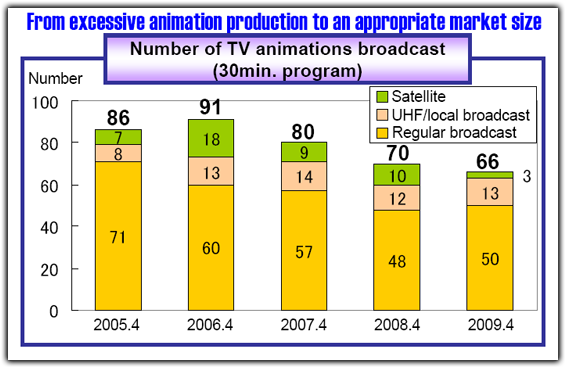
In their Q3 Fiscal 2009 (mid-2008) report, Toei Animation detailed a significant drop in net income, from 1.5 billion yen to a mere 174 million yen. The company quickly revised their forecast for the remainder of Fiscal 2009. Fortunately, the previous years had been financially friendly for Toei Animation, allowing them to maintain their viability as a leading animation company. However, what would Toei Animation do to reverse this situation and ensure continual growth?
大意是說從09年第3季的預測報告中,看出Net Income這方面的收入大幅減少。(不清楚Net Income實際是指什麼的收入)
但由於前一年業績不差,因此能仍然生存。
Toei Animation's Vision for Growth
東映對業績增長的預測
Like any major company, Toei Animation not only develops a plan for current annual (short term) growth, but also a plan for sustainable future (long term) growth. As part of this future growth plan, Toei Animation highlighted in its Q3 Fiscal 2009 (April 2008 to December 2008) report that it had been keeping track of the transition from the analog age to the digital age, noting that March 2009 was well enough into the "Digital Permeating Age" that they could move on to the "Next Stage".
這段主要是說東映會對公司未來一段時間的收入作出預測,對它能順利從模擬信號年代過渡至今的數碼年代及下一個年代。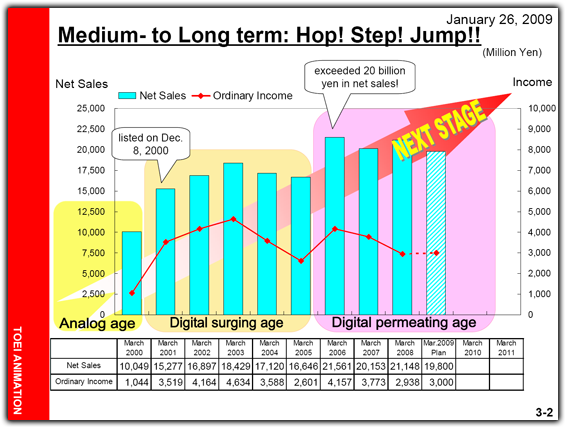
This next stage featured a list of main objectives in how the company could reach its future growth goals. For now we'll just note the specific ones related to this discussion:
TV Animation
The largest animation market, our most important business.
| Constantly maintain four to six stable broadcasting time slots.
|
Collaboration
Production of titles targeted for worldwide distribution.
| Enhance collaboration with overseas media.
|
Library
主要是說這裡會探討東映從「TV動畫、國際性、現有作品庫」這3方面選出來龍珠重製的原因。
From all this we can really get a glimpse of where the idea of DragonBall Kai came from. Toei Animation wanted to do something with a TV anime, as it was their largest and most important market; they wanted it to be an anime that could have a worldwide distribution; and finally, something that would not be "new", but rather something pre-existing from their massive animation library. In Toei Animation's own words, they wanted to "rejuvenate the library again," citing they currently have over 10,000 episodes and movies at their disposal. However, it was not specifically noted that DragonBall had been chosen as their "revitalization" series.
龍珠符合「TV動畫、國際性、現有作品庫」這3個條件。
The DragonBall Kai series was finally announced in the Fiscal 2010 presentation, but with one slight addition to the criteria of why they had decided to go with their flagship property, DragonBall: its attractiveness to various generations. As with many countries around the world, Japan is currently experiencing lower birthrates due to the economic slowdown. With the number of children within this current generation decreasing, Toei Animation felt it needed to establish a solid, continual fanbase to achieve their sustainable growth goals. With the older fanbase of DragonBall already established throughout the world, they could simply add on to it and carry the DragonBall franchise far into the future, ultimately creating a consistent revenue source.
東映需要擁有一群固定及長期的FANS,讓他們的收入可以達到預期的數目。龍珠吸引不同年代的觀眾,老一輩的FANS亦早已遍佈全球,只需把龍珠推出來,就能穩定收入。
It was later announced that the series would be joining the One Piece anime in what Toei Animation and Fuji TV titled the "Dream 9" block. Toei Animation themselves even dubbed this the "back to back action time-slot." The block pulled in significant TV ratings, giving Toei Animation a solid hour to show off two of their most touted franchises. In fact, Toei Animation attributed part of the increase in One Piece licensing sales to this new series collaboration, but that's another story for another time.
把龍珠及ONE PIECE放在一起成為”DREAM 9時段”。甚至製作CROSSOVER動畫。
Their goal for Kai, as stated directly in the presentation, was to "broadcast the HD-remastered classic DRAGON BALL Z, for high-definition television to acquire new fans and encourage a resurgence in popularity." When the series premiered in April 2009, 56.1% of males between the ages of 20-34 and 25.0% of males between the ages of 35-49 were watching Kai, but more importantly, 57.9% of all children in Japan between the ages of 4-12 were watching Kai. Toei Animation even went so far as to map out the course of DragonBall's history in Japan, including its revival in 2002 and their hopes of revitalizing the series.
東映把龍珠高清重製,吸收新一代FANS。最初播放改時,有56.1%的20-34歲男性、25%的35-49歲男性及57.9%的4-12歲小孩子觀看改。東映甚至繪出龍珠在日本的歷史,包括在2002年龍珠的復活及希望能再次興起。

In their Q2 Fiscal 2010 report, Toei Animation examined their plan for DragonBall Kai, stating:
Re-mastered Dragon Ball Z in HD: Faithfully and quickly adapted its story framework to high-definition terrestrial television, with broadcasts commencing from April 2009.
It's quite interesting they would use of the word "quick" in reference to their high definition adaptation of the series, as many fans and critics of the series have often commented that there seems to be very little effort put into its production. From there the report went on to highlight other aspects of the series, such as promotional items, events, card games, video games, and Blu-ray discs.
在2010年第2季的報告中,有某句提及東映打算「快速」重製。可以看出如大部分人所說,東映似乎只打算付很少錢去製作改。

As part of their goals, Toei Animation was also concerned with marketing the series overseas, specifically noting that DragonBall was an "evergreen brand" (essentially a "perennial" brand, as it doesn't have to be "replanted" or "restarted" every time in order for it to grow), as it has stood the test of time. Their stated international goal was "to strengthen the global licensing in other countries, to sustain and to expand the brand." Shortly after the premiere of Kai in Japan, it was announced that FUNimation had licensed the series for distribution in North America under the title DragonBall Z Kai. Many other countries followed suit, rejuvenating the DragonBall series not just domestically in Japan, but globally.
前半段主要說龍珠是”常青品牌”,能夠歷久不衰。後半段主要說龍珠的復甦是全球性,日本播放改後,其他國家亦有播放。

Back in Japan, it slowly started to become clear that things weren't as great as they had once appeared. From the beginning, based on Toei Animation's projected episode count, it appeared as though they were only planning Kai as far ahead as whatever the current arc was. With dwindling sales numbers, and seiyuu confirming they were not being hired to reprise their main roles as Toei Animation didn't have the budget to afford their rates, the fate of Kai seemed to hang in the air for quite some time. Finally, in early March 2011, it was revealed that Kai would indeed be coming to end that month following the conclusion of the Cell arc. So the series was coming to an end, but why?
慢慢展現出龍珠並不能像以前一樣大熱起來。從集數預定看出東映最初只打算播菲利篇,加上銷量下降,以及東映預算不足,請不起聲優。改的情況就像被放在一邊投閒置散,最後決定斯路篇完結。但原因是什麼呢?
Did DragonBall Kai Fail to Deliver?
龍珠改是否傳承失敗
For all intents and purposes, I'm not too sure we can say DragonBall Kai was an actual failure, at least not in the same way we can say DragonBall GT was an absolute failure. For one thing, throughout the course of its run on Fuji TV, DragonBall Kai maintained consistent TV ratings and always ranked among the "Top 10" rated anime series. The series averaged a ratings share of 9.4%, peaking at 12.3% in the middle of the series (episode 47) and hitting a low of 6.4% at the beginning of the Namek arc (episode 18).
主要是說龍珠改收視不差,維持在動畫TOP 10,不能說失敗。

We can also assume that by the time the Cell arc ended, Toei Animation had already met one of its lofty goals for the series: acquiring new fans. The TV ratings indicate they had in fact acquired new fans, and more importantly, younger fans that might someday invest in the series for nostalgia reasons as they become older (similar to all of the series' original fans that paid thousands of dollars for collectors' DVD box sets in the mid-2000s). However, it doesn't appear that the other part of their goal was ever quite met: a resurgence in the series' popularity.
從收視看出東映其中一個目的已達到,就是吸引新FANS。但是龍珠再次流行起來這個目的就沒有達成。
Based on the fiscal reports released by Toei Animation, DragonBall licensing sales and renewed popularity had peaked in Japan during Fiscal 2007 (shown below), just prior to Kai premiering early on in Fiscal 2010 (5 April 2009). By the end of Q3 Fiscal 2011 (31 December 2010), DragonBall-related sales in Japan had reached an all time low within the given data.
大意是說從下圖可以看出東映在國內賣出龍珠版權的收入,在龍珠改播放前的2007年是頂蜂,2010年卻是谷底。
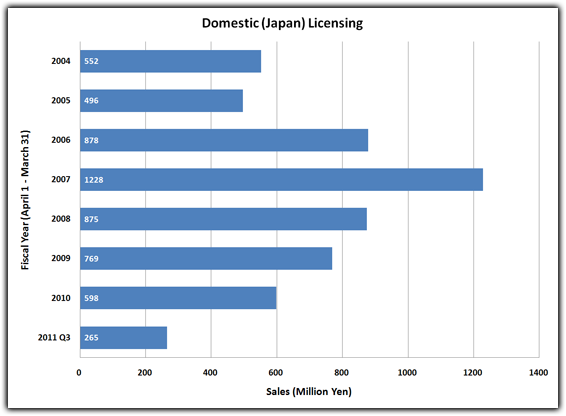 To help gauge the significance of these sales, let's compare the sales numbers of DragonBall with those of the leading anime, One Piece. At the point of Kai's cancellation in Fiscal 2011, One Piece was booming in comparison to the waning sales of DragonBall in Japan. While DragonBall pulled in a mere 265 million yen, Toei Animation saw an astounding 2.45 billion yen in sales revenue from One Piece during Fiscal 2011. In their Q3 Fiscal 2011 report, Toei Animation noted this had far and away exceeded all of their expectations. In addition, both of the Japanese media sales ranking companies SoundScan Japan and Oricon released reports showing that the DragonBall Kai Blu-rays rarely made their "Top 20" ranks. Even when they did, they usually only managed to rank 17-20, and quickly dropped off the charts following the week of their release. To help gauge the significance of these sales, let's compare the sales numbers of DragonBall with those of the leading anime, One Piece. At the point of Kai's cancellation in Fiscal 2011, One Piece was booming in comparison to the waning sales of DragonBall in Japan. While DragonBall pulled in a mere 265 million yen, Toei Animation saw an astounding 2.45 billion yen in sales revenue from One Piece during Fiscal 2011. In their Q3 Fiscal 2011 report, Toei Animation noted this had far and away exceeded all of their expectations. In addition, both of the Japanese media sales ranking companies SoundScan Japan and Oricon released reports showing that the DragonBall Kai Blu-rays rarely made their "Top 20" ranks. Even when they did, they usually only managed to rank 17-20, and quickly dropped off the charts following the week of their release.
簡單來說就是從下圖看出在國內版權收入方面,ONE PIECE遠超龍珠。(題外話1,OP簡直痴線!)(題外話2,如果是統計海外版權收入的話,情況會是相反的!)
另外,Blu Ray銷售排名中,龍珠改的Blu Ray銷量,有時會在頭20名左右,但通常只是17-20名,而且很快會跌出排名以外。
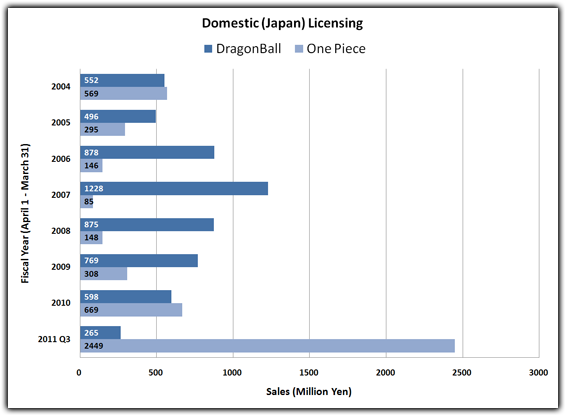 Not only were DragonBall sales declining for Toei Animation, but Namco-Bandai, the company responsible for all merchandise for the franchise, had also been reporting declining sales that mirror Toei Animation's own trends. Not only were DragonBall sales declining for Toei Animation, but Namco-Bandai, the company responsible for all merchandise for the franchise, had also been reporting declining sales that mirror Toei Animation's own trends.
Toys and hobby merchandise for the franchise (which does not include video games, reported separately) jumped slightly from 6.0 billion yen in Fiscal 2006 to 7.9 billion yen in Fiscal 2007 – a height that mirrors Toei Animation's own peak for the franchise that same year. Each subsequent year, however, has seen a massive decline. In their Q3 Fiscal 2011 report, Namco-Bandai reported a total of only 1.7 billion yen for the franchise so far that fiscal year, yet was at least projecting a total of 2.7 billion yen for the full fiscal year by the end of the next quarter (which remains to be seen, of course).
主要是說除了東映,從BANDAI的財政報告中可以看出BANDAI的周邊產品收入亦跟東映很相似。在07年是頂蜂,10年卻是谷底。(注:這些收入並不包括電子遊戲)
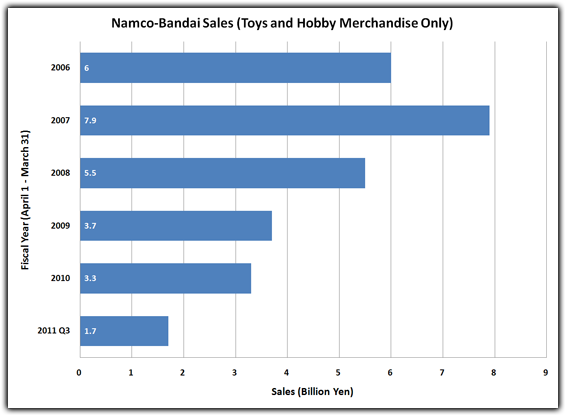
When you include video games in the mix, the franchise has taken a 5 billion yen drop for Namco-Bandai over the last two years, and in their Q3 Fiscal 2011 financial highlights report, was not even listed as a top-performing franchise, the first instance of this in quite some time.
This was not always the case, however. The PlayStation 2 generation and the DragonBall franchise treated Namco-Bandai quite well, but they were not able to carry forward that moderate success. A combination of oversaturation and diminishing quality in development has been called out by fans, and even hinted at by the company, themselves.
如果把遊戲亦一起計算,BANDAI在前2年的收入比較會是下降幅度大於5億。
即使PS2的龍珠GAME表現不太差,但仍然算不上成功。
In Fiscal 2005, Bandai (at that point not yet merged with Namco) noted:
In Japan, while new types of mobile game consoles were released one after another and competition in the software market escalated, the "Dragon Ball Z 3" performed very well as the successor of the previous version.
In France, the United Kingdom, Spain and other European regions, the "Power Rangers" series – particularly, figures – showed quite strong movement. Also, new products from "Strawberry Shortcake", "Tamagotchi Connexion", "Pokémon", "Thunderbirds", etc. became popular. In addition, in the video game software area, the "Dragon Ball Z 3" contributed substantially to operating results.
簡單就說就是龍珠Z3在日本及歐洲國家表現很好,對BANDAI有很大貢獻。
For a couple years, this success carried forward, with specific nods to Europe time and time again. Contrast this, however, with just a year later when the company was already beginning to note:
In the Home Video game software, sales of Tamagotchi Connection: Corner Shop for the Nintendo DS shot past the one million mark in Japan. Super Robot Wars (alpha) 3, Tales of the Abyss, and Dragon Ball Z Sparking! (all for the PlayStation 2), also proved popular in the Japanese market. However, the market was depressed as a whole, and the Company was unable to respond swiftly to changing customer preferences, both in Japan and abroad. Furthermore, sales of other major game titles were slow. As a result, the business as a whole performed poorly, with the Company recording valuation losses on inventory assets.
雖然不少GAME都很流行,但市場有一段時間很不景氣,令BANDAI捐失不少。
DragonBall games would continue to be mentioned less and less until Fiscal 2010, when the franchise received no special nods at all – the exact time period during the shift to the Raging Blast franchise on the PlayStation 3 and Xbox 360, itself coming with additional development costs.
報告中愈來愈少提及龍珠,龍珠RB的開發本身就是額外的開支。(這一段我不太肯定有沒有譯錯)
Fans often point to 2008's first "next-generation" outing for the franchise, Burst Limit, as possibly being a "failure" due to its lack of a sequel. Relative to other franchises, perhaps, but not relative to DragonBall, necessarily. Speaking specifically to the European market, the company noted in 2009 that:
In the Game Contents Business, Soul Calibur IV, developed for the PLAYSTATION 3 and the Xbox360, and Dragon Ball Z: Burst Limit, also for the PLAYSTATION 3 and the Xbox360, and others delivered strong performance.
首部次世代作品龍珠BL是失敗作,但它的失敗跟龍珠無關。
This was the "beginning of the end", so to speak, however. Sales of Burst Limit in Japan hit 92,000 copies on the PS3 as the number-one selling game its first week (with the Xbox 360 version down at number twelve). Two years later, Raging Blast 2 sold half that amount its first week. The same could be seen on the portable front: DragonBall DS 2 in 2010 sold about a quarter of what its predecessor did its first week in 2008, and while this year's Ultimate Butoden managed to push just over 31,000 copies its first week, it is still a shadow of what has been achieved in the past.
主要都是說近年的龍珠GAME銷量不斷減少。
What makes these trends all the more interesting is their relation to DragonBall Kai – a revival of the franchise on television did not carry over to an increase in sales of either video games or merchandise.
It's quite evident that many fans were simply enjoying the free HD broadcasts of the series while not buying any of its merchandise. Unfortunately, no show can survive in Japan without decent merchandise sales, which ultimately funds the show's production. In almost every fiscal presentation during the course of DragonBall Kai's run, Toei Animation would note the "strong performance of character merchandise, DVDs/Blu-rays of One Piece and Pretty Cure." Not once was DragonBall ever mentioned in a similar fashion.
龍珠改的推出不能令周邊及遊戲賣得好,FANS只看TV卻不買周邊,這亦影響了改的製作。
東映公佈表現最好的作品時,幾乎每次都是ONE PIECE及光之美少女,沒有龍珠的蹤影。
This truly became evident in Q2 Fiscal 2011 when Toei Animation noted in its presentation that "under [a] continuous severe business environment, our goal is to aim to create [the] 'next hit title' by securing stable income from the multi-use of the current TV lineups and library titles." In the same presentation, they noted a need to "strengthen the lineup" and even went so far as to say a "new TV lineup was in preparation for the 2011 year." It was most likely at this point that Toei Animation had fully decided to move on from DragonBall Kai. So, using the profits from One Piece and Pretty Cure, they began the process of turning the popular manga series Toriko into their "next hit anime title" and giving it DragonBall Kai's time slot.
從東映的2011年第2季的預測報告中看出,為了有穩定收入,東映需要有下一套新的大熱作品。下圖中提及東映會有新的TV節目表,可能這就是把龍珠改徹走的原因。之後把從OP及光之美少女得出的利潤,全力發展美食的俘虜,並讓他取代龍珠改的時段。
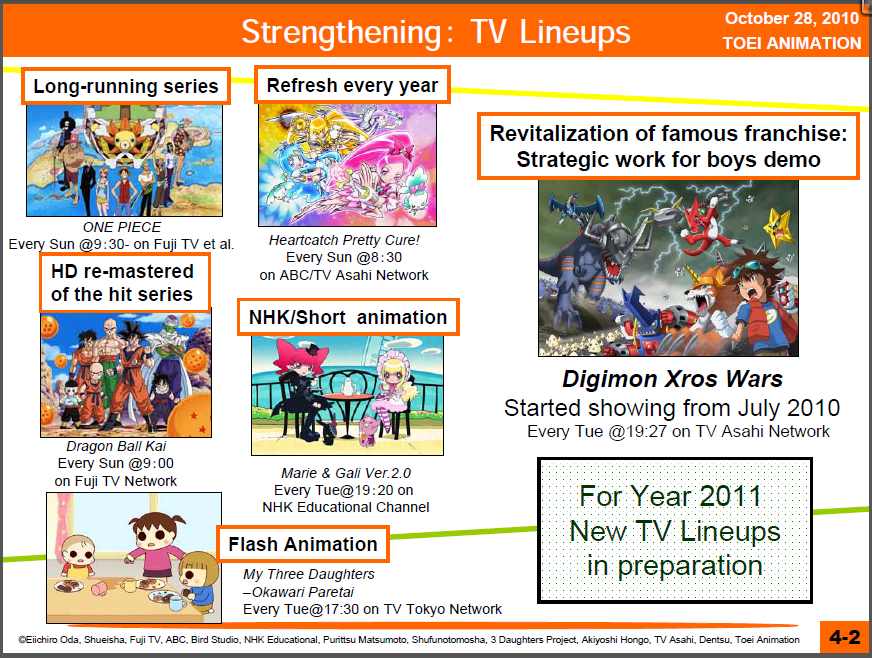
Conclusion
總結
At the moment, it appears that the second wave of DragonBall has officially run its course in Japan, but that doesn't mean it will never return to the land of the rising sun again. DragonBall is a staple, not only to the country, but to Toei Animation as well. Unfortunately, many fans' emotions blind them to the fact that anime is a business, and this time around, DragonBall didn't make the cut. Toei Animation took a risk by simply re-mastering old footage rather than creating something entirely new, and with no reward to that risk, they had to stop the bleeding.
Will DragonBall be back? Undoubtedly it will, at some point in the future. For now, we just have to remember that we lived through the first revival of DragonBall, in a time when you could actually watch the show live in Japan. If anything, the series has now fully been propelled into the digital age, leaving its mark on future generations of fans.
提醒人不要被情感蒙蔽雙眼,不要忘記動畫只是一盤生意。但現在這樣並不代表龍珠會從此消失。龍珠的熱潮會有再反彈的一日。東映現在只是察覺到重製舊東西存在危機,並進行止血。
龍珠一定會再次來臨,我們只是活在龍珠第1次復活的世代。現在只是為將來正式進代數碼年代時新一代的FANS留下印記。
----------------------------------------------------------------------------------------------------------------------------------------------------
個人總結:如果想龍珠復活的話,就付錢購買龍珠產品吧,多些宣傳龍珠吧。為龍珠的復活出一分力!龍珠的復活自然不是夢想!
|
|
 |
|  |
|
